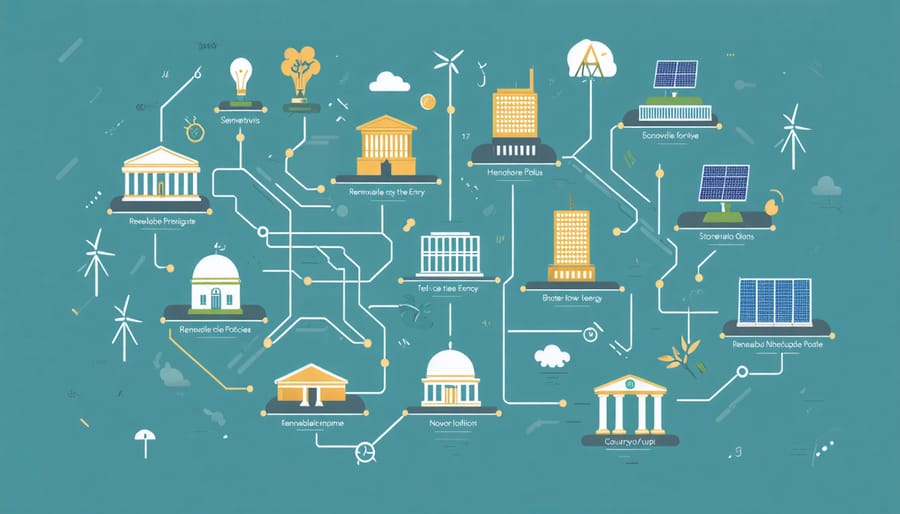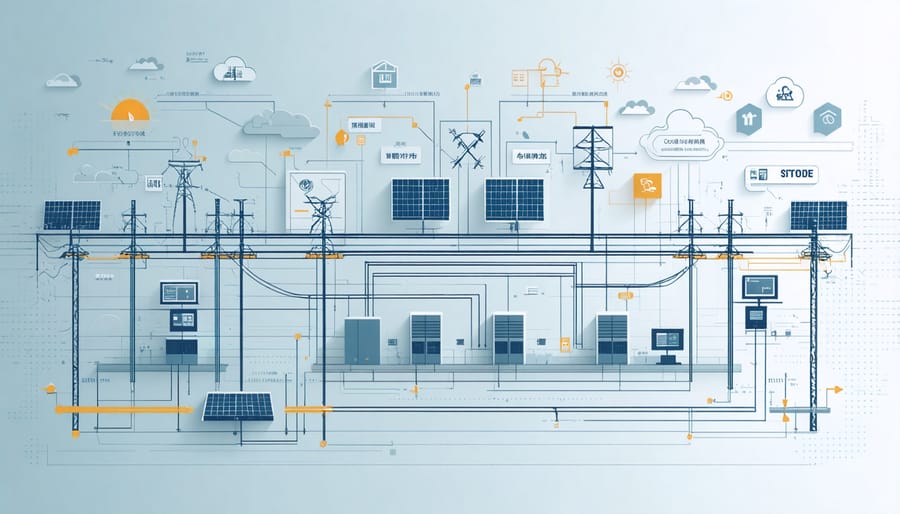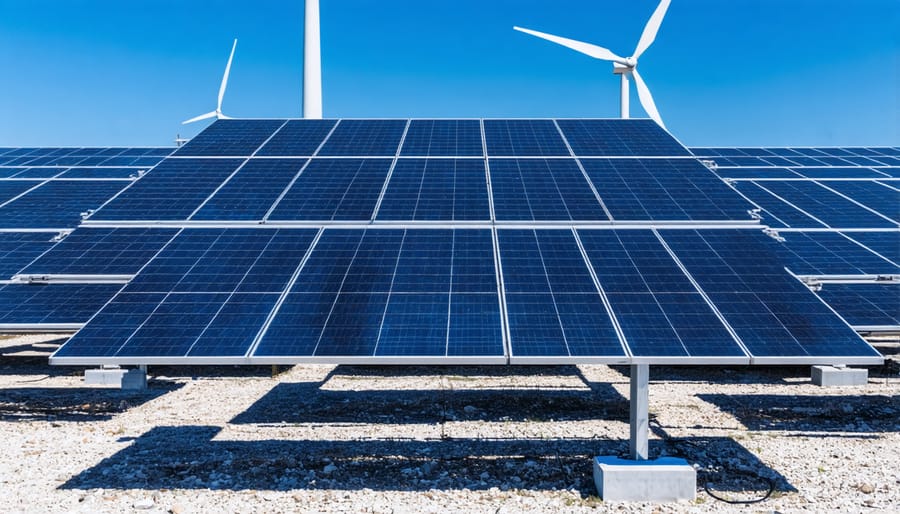Navigating today’s dynamic renewable energy policies demands strategic adaptation from business leaders and facility managers. The global shift toward sustainable power generation has created unprecedented opportunities for organizations to reduce operational costs while meeting increasingly stringent environmental regulations. As governments worldwide accelerate their clean energy transitions, businesses face a complex landscape of incentives, mandates, and compliance requirements that directly impact their bottom line.
Understanding these policy frameworks is no longer optional—it’s a critical business imperative. From federal tax incentives and state-level renewable portfolio standards to local building codes and grid interconnection requirements, each policy layer presents both challenges and opportunities for operational efficiency. Forward-thinking organizations are leveraging these policies to secure long-term energy cost stability, enhance their competitive position, and demonstrate environmental leadership to stakeholders.
This evolving regulatory environment requires facility managers and business decision-makers to develop comprehensive strategies that align operational needs with policy compliance while maximizing available incentives and support mechanisms. Success in this new energy landscape demands proactive engagement with policy frameworks and careful consideration of how renewable energy integration can drive business value.
Current Renewable Energy Policy Framework

Federal vs. State Policies
The relationship between federal and state renewable energy policies creates a dynamic framework that shapes the energy landscape across the United States. Federal policies, such as the Investment Tax Credit (ITC) and Production Tax Credit (PTC), establish baseline incentives that apply nationwide. These programs provide crucial financial support for renewable energy projects, while federal research funding drives technological advancement and cost reduction.
State policies often build upon this federal foundation with more aggressive renewable portfolio standards (RPS) and local incentives. For example, California’s ambitious goal of 100% clean electricity by 2045 significantly exceeds federal targets. States also maintain authority over utility regulation, interconnection standards, and permitting processes, allowing them to tailor programs to their specific resources and needs.
This dual-layer approach creates both opportunities and challenges for businesses. While multiple incentive programs can increase project viability, navigating different jurisdictional requirements demands careful planning. Organizations must understand both federal and state policies to optimize their renewable energy strategies and maximize available benefits. Success often depends on leveraging complementary policies across both levels while maintaining compliance with evolving regulations.
Financial Incentives and Support Mechanisms
Financial incentives play a crucial role in accelerating renewable energy adoption across various sectors. Investment Tax Credits (ITC) offer businesses up to 30% reduction in solar and wind project costs, while Production Tax Credits (PTC) provide per-kilowatt-hour benefits for renewable energy generation. Many states complement these federal programs with additional incentives like Solar Renewable Energy Certificates (SRECs) and performance-based incentives.
Grant programs, such as the Rural Energy for America Program (REAP), support agricultural producers and rural businesses in implementing renewable energy solutions. Accelerated depreciation through the Modified Accelerated Cost Recovery System (MACRS) enables businesses to recover renewable energy investments more quickly, improving project economics.
Green financing options, including Property Assessed Clean Energy (PACE) programs, provide long-term funding with competitive rates. Utility companies often offer rebates and net metering arrangements, allowing businesses to offset their energy costs through on-site generation. Performance contracts and power purchase agreements (PPAs) provide alternative financing structures, enabling organizations to implement renewable energy projects with minimal upfront capital investment.
These support mechanisms, combined with declining technology costs, create compelling business cases for renewable energy adoption across industrial, commercial, and institutional sectors.
Grid Modernization Initiatives
Smart Grid Technologies
Modern power distribution networks are evolving rapidly through the integration of smart grid technologies, which enable real-time monitoring, automated load balancing, and dynamic energy management. These advanced systems incorporate sophisticated sensors, two-way communication capabilities, and artificial intelligence to optimize power distribution and consumption patterns.
The implementation of smart grid infrastructure delivers multiple benefits for businesses and utilities alike. Advanced metering infrastructure (AMI) provides detailed consumption data, enabling facility managers to identify peak usage periods and optimize their energy strategies. Automated demand response programs allow organizations to participate in grid stabilization efforts while receiving financial incentives for reducing consumption during high-demand periods.
Grid modernization initiatives also support the seamless integration of distributed energy resources (DERs), including on-site solar installations and energy storage systems. This capability enables businesses to participate in energy markets as both consumers and producers, creating new revenue streams through excess power sales and grid services.
For facility managers, smart grid adoption translates to enhanced reliability, reduced operational costs, and improved energy efficiency. Real-time monitoring and predictive maintenance capabilities help prevent outages and extend equipment life spans, while automated systems optimize power quality and reduce waste. These improvements contribute to both environmental sustainability goals and bottom-line performance.

Energy Storage Integration
Energy storage systems have become a crucial component in the successful integration of renewable energy sources into modern power grids. As intermittent sources like wind and solar continue to expand, storage solutions provide the necessary flexibility and reliability to maintain grid stability and ensure consistent power delivery.
Battery energy storage systems (BESS) represent the most widely adopted solution, with lithium-ion technology leading the market. These systems enable businesses and utilities to store excess renewable energy during peak production periods and deploy it during times of high demand or low generation. This capability not only enhances grid reliability but also provides significant economic benefits through demand charge reduction and energy arbitrage opportunities.
Policy frameworks increasingly recognize the vital role of storage in renewable energy adoption. Many jurisdictions now mandate storage requirements for new renewable energy installations or offer incentives for integrated storage solutions. For example, several states have implemented storage procurement targets and tax incentives to accelerate deployment.
Advanced energy storage technologies, including flow batteries, compressed air storage, and hydrogen systems, are also gaining traction. These alternatives offer unique advantages for different applications and scales of operation. The integration of artificial intelligence and smart grid technologies further optimizes storage system performance, enabling predictive maintenance and automated dispatch decisions.
For facility managers and business owners, understanding storage integration requirements and opportunities is essential for long-term energy planning and compliance with evolving regulations.

Business Impact and Opportunities
Cost-Benefit Analysis
The financial implications of renewable energy policies demonstrate compelling returns on investment across multiple sectors. Analysis shows that businesses implementing renewable energy solutions typically achieve payback periods of 3-7 years, with subsequent decades of reduced operational costs. Initial capital investments in solar and wind infrastructure are offset by substantial long-term savings, tax incentives, and increased property values.
Recent market studies indicate that companies embracing renewable energy policies experience an average 15-20% reduction in energy costs within the first year. These savings compound over time, creating new business opportunities in renewable energy and improving bottom-line performance.
When factoring in government incentives, renewable energy certificates, and feed-in tariffs, the net present value (NPV) of renewable energy investments often exceeds traditional energy infrastructure investments by 30-40%. Additionally, organizations implementing comprehensive renewable energy strategies report enhanced brand value, improved stakeholder relations, and stronger competitive positioning in their respective markets.
The cost-benefit equation becomes even more favorable when considering the declining prices of renewable technologies, with solar panel costs dropping by approximately 70% over the past decade and wind turbine efficiency continuing to improve year over year.
Compliance Requirements
Organizations implementing renewable energy solutions must adhere to a comprehensive framework of compliance requirements established by federal, state, and local authorities. These regulations typically encompass equipment certification standards, installation protocols, and operational guidelines to ensure safety and efficiency.
Key compliance areas include interconnection standards for grid-tied systems, which specify technical requirements for connecting renewable energy installations to the utility grid. Organizations must obtain necessary permits, complete environmental impact assessments, and meet zoning requirements before project implementation.
Building codes and safety standards play a crucial role, particularly for roof-mounted solar installations and wind energy systems. Facilities must comply with structural requirements, fire safety regulations, and electrical codes specific to renewable energy systems.
Reporting and documentation requirements are equally important. Organizations must maintain detailed records of energy production, consumption patterns, and system maintenance. Many jurisdictions require regular compliance audits and certification renewals to maintain operational status.
For businesses participating in renewable energy credit (REC) programs or carbon offset markets, additional compliance measures include verification of energy generation claims and adherence to trading protocols. Organizations should also stay informed about evolving regulations and prepare for future compliance requirements as renewable energy policies continue to develop.
Implementation Strategies
Technology Integration
Successful renewable energy policy implementation requires seamless integration of advanced technologies across multiple systems. Smart grid infrastructure serves as the foundation, enabling bi-directional power flow and real-time monitoring of energy consumption and generation. Organizations should prioritize the installation of smart meters and energy management systems (EMS) to optimize resource allocation and track performance metrics.
Integration strategies should focus on three key components: grid connectivity, storage solutions, and monitoring systems. Modern inverter technologies ensure smooth power conversion and grid synchronization, while battery storage systems help balance supply and demand fluctuations. Advanced monitoring platforms provide detailed analytics and reporting capabilities, essential for compliance and optimization.
Facility managers should consider implementing automated demand response systems that can adjust energy consumption based on grid conditions and pricing signals. Cloud-based management platforms enable remote monitoring and control, while predictive maintenance algorithms help prevent system failures and optimize performance.
For maximum effectiveness, organizations should develop a phased implementation approach, starting with core infrastructure upgrades before adding more sophisticated technologies. This approach allows for better resource allocation and helps minimize disruption to existing operations while ensuring compliance with evolving regulatory requirements.
Policy Navigation
To maximize renewable energy policy benefits, organizations should follow a structured approach to navigation and compliance. Begin by conducting a comprehensive policy audit to identify applicable federal, state, and local regulations affecting your operations. This assessment should include available incentives, tax credits, and compliance requirements specific to your jurisdiction.
Develop a clear implementation timeline that aligns with policy deadlines and your organization’s capabilities. Establish a dedicated team responsible for policy monitoring and compliance, ensuring regular updates on regulatory changes and emerging opportunities. Consider engaging energy policy consultants to provide specialized guidance and maximize available benefits.
Document all renewable energy initiatives and maintain detailed records of compliance activities. This documentation proves invaluable during audits and helps demonstrate ROI to stakeholders. Regularly review and update your renewable energy strategy to incorporate new policies and technological advancements.
Create a stakeholder communication plan to keep management, employees, and investors informed about policy-related decisions and their impact on operations. Network with industry associations and participate in policy forums to stay ahead of upcoming regulations and share best practices with peers.
Finally, establish metrics to measure policy compliance effectiveness and track the financial impact of renewable energy initiatives. Regular assessment helps optimize your approach and ensures continued alignment with evolving regulatory frameworks.
Future Outlook
The renewable energy policy landscape is poised for significant transformation over the next decade. Industry analysts project accelerated adoption of clean energy initiatives worldwide, driven by technological advancements and increasing climate urgency. Recent policy implementation results indicate a clear trend toward more ambitious renewable energy targets and stronger regulatory frameworks.
Key developments expected to shape the future include the standardization of carbon pricing mechanisms, enhanced grid interconnection policies, and expanded incentive programs for business adoption. Markets are likely to see more sophisticated policy instruments that combine multiple objectives, such as linking renewable energy requirements with energy storage mandates and grid reliability standards.
For businesses, this evolution presents both opportunities and compliance considerations. Organizations can expect more stringent renewable portfolio standards, particularly in developed economies, alongside increased support for distributed energy resources and microgrids. Financial mechanisms, including green bonds and environmental, social, and governance (ESG) investment frameworks, will likely play a larger role in policy implementation.
Emerging technologies, particularly in energy storage and smart grid systems, will influence policy development. Regulators are expected to focus on grid modernization policies that support increased renewable integration while maintaining system reliability. This may include new requirements for demand response capabilities and advanced metering infrastructure.
Regional cooperation in policy development is anticipated to grow, with cross-border initiatives becoming more common. This could lead to harmonized standards and interconnected renewable energy markets, creating new opportunities for businesses operating across multiple jurisdictions.
The evolving landscape of renewable energy policy presents both opportunities and responsibilities for businesses across sectors. Success in this transition requires a strategic approach that combines policy compliance with sustainable business practices. Organizations should start by conducting comprehensive energy audits to identify opportunities for renewable integration and efficiency improvements. Following this, developing a clear implementation timeline that aligns with current and anticipated policy requirements will ensure smooth adaptation to new regulations.
Key action steps include engaging with utility providers to understand available incentives, investigating power purchase agreements (PPAs), and evaluating on-site generation possibilities. Businesses should also consider joining industry associations and policy forums to stay informed about regulatory changes and participate in shaping future policies.
Investment in employee training and sustainable infrastructure will position organizations favorably as renewable energy policies continue to evolve. By taking proactive steps now, businesses can not only ensure compliance but also gain competitive advantages through reduced operating costs and enhanced brand reputation. The transition to renewable energy represents a crucial strategic opportunity that forward-thinking organizations cannot afford to ignore.

